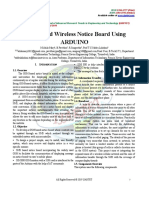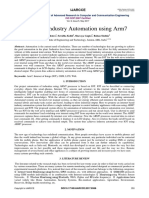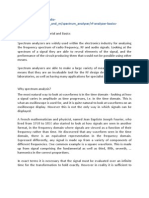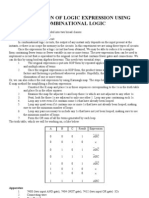Digital Data Displaying Board Using GSM
Digital Data Displaying Board Using GSM
Uploaded by
Alamgir Kabir ShuvoCopyright:
Available Formats
Digital Data Displaying Board Using GSM
Digital Data Displaying Board Using GSM
Uploaded by
Alamgir Kabir ShuvoOriginal Title
Copyright
Available Formats
Share this document
Did you find this document useful?
Is this content inappropriate?
Copyright:
Available Formats
Digital Data Displaying Board Using GSM
Digital Data Displaying Board Using GSM
Uploaded by
Alamgir Kabir ShuvoCopyright:
Available Formats
ISSN (Print) : 2320 – 3765
ISSN (Online): 2278 – 8875
International Journal of Advanced Research in Electrical,
Electronics and Instrumentation Engineering
(An ISO 3297: 2007 Certified Organization)
Website: www.ijareeie.com
Vol. 6, Issue 3, March 2017
Digital Data Displaying Board Using GSM
Kanimozhi.M1, Kiruthika shree.K1, Kousalya.K1, Kesavamoorthy.T1, Kalaiyarasi.V2
UG Students, Department of ECE, K.S.Rangasamy College of Technology, Tiruchengode, Tamil Nadu, India1
Assistant Professor, Department of ECE, K.S.Rangasamy College of Technology, Tiruchengode, Tamil Nadu, India2
ABSTRACT: Notice board plays a major role in human’s day to day life. It is mostly used in any institution or
organization or public sectors like bus stops, railway stations, shops etc. In early times, lots of papers are used to
communicate others. The proposed technology of notice board using GSM will reduce the wastage of papers. Smart
phones are mostly used by everyone. The messages are texted through mobiles likewise, SMS based notice board using
GSM Modem, displays the messages on notice boards by using mobile phone. Modem is being connected directly to
PC or to any Microcontrollers. It is used for data logging and control. The SIM is used for our convenience where it is
inserted in a slot available on GSM Modem. Monitor is used to display the message that sent from our mobile phone to
the notice board. In this Raspberry pi is used as the main Controller. One of the most exciting things about the
Raspberry Pi is that it comes equipped with a HDMI connector, meaning that anyone with a HDMI-compatible monitor
can easily connect the device. Along with the SD card and power supply, the HDMI cable is one of the most important
pieces of equipment that can be used with Raspberry Pi, which means that can connect it to a wide selection modern
desktop computer monitors.
KEY TERMS: Raspberry Pi, GSM Modem and MAX 232 level converter, LCD Display, Embedded C, C Python.
I. INTRODUCTION
Notice Board is used in various institutes to display notices and these boards are managed manually. It is a
long process to put up notices on the notice board. This wastes a lot of resources like paper, printer ink, man power and
also loss of time. In this paper we have proposed a system which will enable people to wirelessly transmit notices on
notice board. The project aims at designing a LCD Monitor based message display controlled from a mobile phone.
The proposed system makes use of wireless technology to communicate from Mobile phone to Raspberry Pi display
board. The system has a provision for giving message through text. This project makes use of an on board computer,
which is commonly termed as Raspberry Pi processor. It acts as heart of the project. This onboard computer can
efficiently communicate with the output and input modules which are being used. The Raspberry Pi is a credit-card-
sized single-board computer developed in the UK by the Raspberry Pi Foundation. The Raspberry Pi does not include
a built-in hard disk or solid-state drive, but uses an SD card for booting and long-term storage. The main controlling
device of the whole system is a Raspberry Pi processor. GSM modem is interfaced to Raspberry Pi processor. The
message sent through predefined application from user mobile phone is received by the GSM modem. GSM modem
feds this information to Raspberry Pi processor which process it and displays it on the LCD display. Also, the
Raspberry Pi processor horns a buzzer for every new message
Copyright to IJAREEIE DOI:10.15662/IJAREEIE.2017.0603066 1519
ISSN (Print) : 2320 – 3765
ISSN (Online): 2278 – 8875
International Journal of Advanced Research in Electrical,
Electronics and Instrumentation Engineering
(An ISO 3297: 2007 Certified Organization)
Website: www.ijareeie.com
Vol. 6, Issue 3, March 2017
II. DESIGN LAYOUT
The block diagram For Wireless GSM based electronic notice display is shown in figure 1.
Figure. 1
In proposed system consists of two section 1.Transmitting section, 2.Receiving section. Transmitting section consists of
just a mobile. Any type of user (SIM number) can be used, as users are assigned password for accessing the system.
Authorized users send the message that they want to display on the notice board to the receiving section’s mobile
number and the message will be displayed only if the users have the authentication password.
Receiving section on the other hand consists of a GSM modem to receive message. Received SMS is then extracted
byPC.SMS is then sent to microcontroller (Raspberry Pi) using MAX232 IC and PC’s serial port. Microcontrollers
(Raspberry pi) finally display it on the LCD board.
III. HARDWARE DESCRIPTION
In proposed system consists of four units
1. Controller module
2. GSM module
3. Wi-Fi module
4. User module
1. CONTROLLER MODULE
Microcontroller is a small computer on a single integrated circuit containing a processor core, memory and
programmable I/O peripherals. It is single motherboard, without housing, power supply, keyboard, mouse and screen.
In this module the controller can be interfaced with monitor and the mobile number can be stored in the controller it act
as a main part of the wireless notice board.
2. GSM MODULE
The GSM modem is interfaced through level shifter IC for establishing RS232 communication protocol to
the microcontroller. The message so received is thus sent to the microcontroller that further displays it on electronic
notice board which is equipped with a monitor display interfaced to a microcontroller powered by a regulated power
supply from mains supply of 230 volt ac.
Copyright to IJAREEIE DOI:10.15662/IJAREEIE.2017.0603066 1520
ISSN (Print) : 2320 – 3765
ISSN (Online): 2278 – 8875
International Journal of Advanced Research in Electrical,
Electronics and Instrumentation Engineering
(An ISO 3297: 2007 Certified Organization)
Website: www.ijareeie.com
Vol. 6, Issue 3, March 2017
3. WI-FI MODULE
Wi-Fi module is act as a receiver. Wi-Fi uses the latest 802.11n wireless technology, and can support data
rates up to 150Mb/s, compared with the older 54Mb/s 11g products.
4. USER MODULE
The user module consists of mobile with SIM (Subscriber Identity Module). It is a chip-on small card
consisting of user’s information as well as phone book. The mobile number has been stored in the microcontroller. It
acts as a transmitter for wireless electronic notice board.
IV. SOFTWARE DESCRIPTION
Python is a widely used high-level, general-purpose, interpreted, dynamic programming language. Its design
philosophy emphasizes code readability, and its syntax allows programmers to express concepts in fewer lines of code
than possible in languages such as C++ or Java. The language provides constructs intended to enable writing clear
programs on both a small and large scale. Python supports multiple programming paradigms, including object-oriented,
imperative and functional programming or procedural styles. It features a dynamic type system and automatic memory
management and has a large and comprehensive standard library. Python interpreters are available for many operating
systems, allowing Python code to run on a wide variety of systems. Using third-party tools, such as Py2exe or
Pyinstaller, Python code can be packaged into stand-alone executable programs for some of the most popular operating
systems, so Python-based software can be distributed to, and used on, those environments with no need to install a
Python interpreter. C Python, the reference implementation of Python, is free and open-source software and has a
community-based development model, as do nearly all of its variant implementations. C Python is managed by the non-
profit Python Software Foundation.
V. ALGORITHM OF THE SYSTEM
Figure. 2
Copyright to IJAREEIE DOI:10.15662/IJAREEIE.2017.0603066 1521
ISSN (Print) : 2320 – 3765
ISSN (Online): 2278 – 8875
International Journal of Advanced Research in Electrical,
Electronics and Instrumentation Engineering
(An ISO 3297: 2007 Certified Organization)
Website: www.ijareeie.com
Vol. 6, Issue 3, March 2017
VI. OUTPUT
Figure. 3
Raspberry pi is interfaced with LCD (figure. 3) to display messages in both Tamil and English font.
Figure. 4
Messages displayed in Tamil font (figure. 4).
Figure. 5
Copyright to IJAREEIE DOI:10.15662/IJAREEIE.2017.0603066 1522
ISSN (Print) : 2320 – 3765
ISSN (Online): 2278 – 8875
International Journal of Advanced Research in Electrical,
Electronics and Instrumentation Engineering
(An ISO 3297: 2007 Certified Organization)
Website: www.ijareeie.com
Vol. 6, Issue 3, March 2017
Messages displayed in English font (figure. 5).
VII. CONCLUSION
This helps to display the message continuously in both Tamil and English font. It is done by using Raspberry
pi where the messages are stored and which is interfaced with LCD notice board where the message is displayed. The
message is send through GSM Modem by authorized user. It reduces the usage of paper. It helps to reduce the wastage
of time.
VIII. FUTURE WORK
In future, the system will also help to display the audio, video, and picture messages which will store in
Raspberry pi and it would be the password protected.
REFERENCES
[1] N. Jagan Mohan Reddy, G.Venkareshwarlu, “Wireless Electronic Display Board Using GSM Technology ,” vol. 1, no. 1, Dec 2013
[2] Gowtham.R, Kavipriya.K, Kesavaraj.G, Natheena.A, Maragatharaj.S, “Multiuser Short Message Service Based Wireless Electronic
Notice Board” Syst., vol.2, no. 1,pp.1-4, April.2013.
[3] Yash Teckchandani, G. Siva Perumal, Radhika Mujumdar, Sridhar Lokanathan, “Large Screen Wireless Notice Display System,”in proc.
IEEEperCom, Dec. 2015.
[4] Sayidul Morsalin, Abdur Rahman, “Password Protected Multiuser Wireless Electronic Noticing System by GSM with Robust Algorithm,”
in Proc. EICTPerCom, 2015.
[5] Ramchandra K. Gurav, Rohit Jagtap, “Wireless Digital Notice Board Using GSM Technology,”in proc.IJERT , vol. 2, no. 1, Dec. 2015.
[6] Pawan Kumar, Vikas Bhrdwaj, Kiran Pal, Narayan Singh Rathor, Amit Mishra, “GSM based e-Notice Board: Wireless Communication,”
in Proc.IJSCE , Vol. 2, no. 3, July 2012.
[7] B.V.Sowjanya, “Moving Message in GSM Based Low Power E-Notice Display,” in Proc. GJTE, vol. 2, no.4, April 2015.
[8] Mitesh Santhakumar, Prasad Bhagat, Ujjwal Rajjpurohit, Nitesh Mhatre, Prof Varsha Bodade, “Wireless E-Notice Board,” IOSR-JCE,
vol. 18, no. 2, Mar-Apr 2016.
[9] Jaiswal Rohit , Kalawade Sanket , Kore Amod , Lagad Sanket, “GSM Supported E-Notice Board,” IJARIIE, vol. 2, no. 3, 2016.
[10] Prachee U.Ketkar, Kunal P.Tayade, Akash P. Kulkarni, Rajkishor M.Tugnayat, “GSM Mobile Phone Based LED Scrolling Message
Display System” vol. 2, no. 3, April 2013.
[11] Bollen L, Eimler, S Hoppe H U, “SMS based Discussions Technology Enhanced Collaboration for the Literature Course,” IEEE, May
2004.
[12] Vijay Kumar Garg, Joseph E Wilkes, “Principle and Application of GSM”, 1999.
[13] Payal Mishra, Pinki Singh, Shivani Gupta, “Sms Based Wireless Notice Board Display Using Gsm Mobile,” IJARSE, vol. 2, no.10, Oct
2013.
[14] Smt.M.Baby, P.Harini, Y.Eleena Slesser, Y.Tejaswi, K.Ramajyothi, M.Sailaja, K.Annie Sumantha, “SMS Based Wireless E Notice
Board,” IJETAE, vol. 3, no. 3, March 2013.
[15] Jaiswal Rohit , Kalawade Sanket , Kore Amod , Lagad Sanket, “Digital - Notice Board,” IJARCET, vol. 4, no. 11, Nov 2015.
Copyright to IJAREEIE DOI:10.15662/IJAREEIE.2017.0603066 1523
You might also like
- ESP32 Programming for the Internet of Things: JavaScript, AJAX, MQTT and WebSockets SolutionsFrom EverandESP32 Programming for the Internet of Things: JavaScript, AJAX, MQTT and WebSockets SolutionsRating: 5 out of 5 stars5/5 (2)
- Wireless Information Display System With Audio Using GSM and Arduino (Atmega328P-Pu)Document4 pagesWireless Information Display System With Audio Using GSM and Arduino (Atmega328P-Pu)kiran vemulaNo ratings yet
- Aurdino Based Automatic Plant Watering System With Internet of ThingsDocument8 pagesAurdino Based Automatic Plant Watering System With Internet of ThingsAanam FathimaNo ratings yet
- Iot Based Web Controlled Notice Board: International Research Journal of Engineering and Technology (Irjet)Document4 pagesIot Based Web Controlled Notice Board: International Research Journal of Engineering and Technology (Irjet)Nayan SolanKiNo ratings yet
- Raspberry Pi and Iot Based Family Robot: IjarcceDocument6 pagesRaspberry Pi and Iot Based Family Robot: Ijarccevenkiscribd444No ratings yet
- IOT Based Smart Home With Load ControlDocument8 pagesIOT Based Smart Home With Load ControlIJRASETPublicationsNo ratings yet
- Wireless Notice Board With Wide RangeDocument5 pagesWireless Notice Board With Wide RangeIJARTETNo ratings yet
- Home Automation With MATLAB and ARDUINO InterfaceDocument7 pagesHome Automation With MATLAB and ARDUINO Interfacedeviselva75No ratings yet
- Wireless Industrial Automtion Using ArduinoDocument5 pagesWireless Industrial Automtion Using ArduinoAbhijith SurendranNo ratings yet
- Android and Bluetooth Technology Enabled Remote Control Using Smart PhoneDocument8 pagesAndroid and Bluetooth Technology Enabled Remote Control Using Smart Phonejehan11No ratings yet
- IoT BASED SMART HOUSE and SHORT CIRCUITDocument3 pagesIoT BASED SMART HOUSE and SHORT CIRCUITfiyoviw911No ratings yet
- Effective Identification of Black Money, Fake Currency & Expiry Using NFC, IOT & AndroidDocument11 pagesEffective Identification of Black Money, Fake Currency & Expiry Using NFC, IOT & AndroidKeshavardhan D.RNo ratings yet
- GSM Based Home Automation SystemDocument4 pagesGSM Based Home Automation Systemvishnu teja MulakaNo ratings yet
- Automate and Secure Your Home Using Zigbee TechnologyDocument4 pagesAutomate and Secure Your Home Using Zigbee TechnologyKais BahrouniNo ratings yet
- Raspberry Pi and Iot Based Family Robot: IjarcceDocument6 pagesRaspberry Pi and Iot Based Family Robot: IjarcceSreeja ReddyNo ratings yet
- 5 - BKEC-168-Smart Drip Irrigation System Using Raspberry Pi and ArduinoDocument8 pages5 - BKEC-168-Smart Drip Irrigation System Using Raspberry Pi and ArduinoKarem Meza CapchaNo ratings yet
- 5 VI June 2017Document6 pages5 VI June 2017Rajesh PatelNo ratings yet
- 8 RaspberryDocument10 pages8 RaspberryMuhammad ToyeebNo ratings yet
- SMS Enabled Display Board Using Internet of ThingsDocument6 pagesSMS Enabled Display Board Using Internet of ThingsInternational Journal of Innovative Science and Research TechnologyNo ratings yet
- Home Automation System Using Based On IoTDocument17 pagesHome Automation System Using Based On IoTIJRASETPublicationsNo ratings yet
- Optimized Locking and Unlocking A System Using ArduinoDocument6 pagesOptimized Locking and Unlocking A System Using ArduinoAbil Wali AkbarNo ratings yet
- Fuel Management SystemDocument7 pagesFuel Management SystemShweta KompaNo ratings yet
- Iot Based Automatic College Gong: S.Arockia Ranjith Kumar, R.Glarwin, M.Gowthamaraj, M.K.Vijayanainar, G.ShunmugalakshmiDocument3 pagesIot Based Automatic College Gong: S.Arockia Ranjith Kumar, R.Glarwin, M.Gowthamaraj, M.K.Vijayanainar, G.ShunmugalakshmiMohseen SNo ratings yet
- Home Automation Based On IoT Using Google AssistantDocument6 pagesHome Automation Based On IoT Using Google AssistantIJARTETNo ratings yet
- Android Controlled Notice Board: Prof. Neha TiwariDocument4 pagesAndroid Controlled Notice Board: Prof. Neha TiwariNayan SolanKiNo ratings yet
- Design and Implementation of Password Based Security Lock SystemDocument6 pagesDesign and Implementation of Password Based Security Lock SystemYashika choudharyNo ratings yet
- Ijarcce 173 PDFDocument5 pagesIjarcce 173 PDFTamil ArasanNo ratings yet
- IR Based Home Appliances ControlDocument6 pagesIR Based Home Appliances ControlClement RajNo ratings yet
- GSM Based Wireless Notice Board Using ARDUINODocument9 pagesGSM Based Wireless Notice Board Using ARDUINOIJARTET0% (1)
- (IJCST-V5I2P71) :prof. Prashant Rathod, Syed Khizaruddin, Rashmi Kotian, Shubham LalDocument6 pages(IJCST-V5I2P71) :prof. Prashant Rathod, Syed Khizaruddin, Rashmi Kotian, Shubham LalEighthSenseGroupNo ratings yet
- Wireless Notice Board Based On Arduino ADocument4 pagesWireless Notice Board Based On Arduino ASAAASNo ratings yet
- ElectricalDocument4 pagesElectricalRahul RockyNo ratings yet
- Digital Notice Board With Real Time ClockDocument4 pagesDigital Notice Board With Real Time ClockInternational Journal of Innovative Science and Research TechnologyNo ratings yet
- A Smart ZIGBEE Based Wireless Sensor Meter System: Christos Tatsiopoulos Aphrodite KtenaDocument4 pagesA Smart ZIGBEE Based Wireless Sensor Meter System: Christos Tatsiopoulos Aphrodite KtenaShobhit JainNo ratings yet
- Office Automation & Attendance System Using IoTDocument4 pagesOffice Automation & Attendance System Using IoTAnonymous kw8Yrp0R5rNo ratings yet
- Hand Gesture Recognition and Cleaning RobotDocument8 pagesHand Gesture Recognition and Cleaning RobotIJRASETPublicationsNo ratings yet
- Iot Based Home Automation System With Wifi On Arduino Using Android ApplicationDocument7 pagesIot Based Home Automation System With Wifi On Arduino Using Android ApplicationHassan RazaNo ratings yet
- Smart Home Automation Based On Iot Using Arduino Mega: Abstract-In The Advancement of TechnologiesDocument4 pagesSmart Home Automation Based On Iot Using Arduino Mega: Abstract-In The Advancement of TechnologiesUdupiSri groupNo ratings yet
- Final ExamDocument5 pagesFinal ExamVinh Trần thếNo ratings yet
- Real Time Digi Notice Board System Using Iot IJERTCONV5IS17021 PDFDocument5 pagesReal Time Digi Notice Board System Using Iot IJERTCONV5IS17021 PDFAlamgir Kabir ShuvoNo ratings yet
- Voice Based E-Notice Board Using AndroidDocument9 pagesVoice Based E-Notice Board Using Androidgoutham p100% (1)
- Smart Home Control Iot WIFI Module (Sensor)Document6 pagesSmart Home Control Iot WIFI Module (Sensor)ToyKyiNo ratings yet
- Voice Controlled Wireless Electronic Notice Board Using AndroidDocument7 pagesVoice Controlled Wireless Electronic Notice Board Using AndroidIJRASETPublicationsNo ratings yet
- Smart Parking Application Using IOTDocument4 pagesSmart Parking Application Using IOTDavid BilllaaNo ratings yet
- Smart Home Automation With Home Security Using IoTDocument7 pagesSmart Home Automation With Home Security Using IoTGRD JournalsNo ratings yet
- Automatic Door Access Control System Based On Facial Recognition Using ESP32-CAMDocument7 pagesAutomatic Door Access Control System Based On Facial Recognition Using ESP32-CAMIJRASETPublicationsNo ratings yet
- Multi-Functional Home Automation System Using Iot: IPASJ International Journal of Computer Science (IIJCS)Document5 pagesMulti-Functional Home Automation System Using Iot: IPASJ International Journal of Computer Science (IIJCS)International Journal of Application or Innovation in Engineering & ManagementNo ratings yet
- V3i409 PDFDocument3 pagesV3i409 PDFIJCERT PUBLICATIONSNo ratings yet
- Intelligent Home Automation Using IoTDocument10 pagesIntelligent Home Automation Using IoTIJRASETPublicationsNo ratings yet
- A Review On Iot Based Smart Home Using Blynk FrameworkDocument9 pagesA Review On Iot Based Smart Home Using Blynk FrameworkTodirica Laurentiu GabrielNo ratings yet
- Implementation of PIC16F877A Based Intelligent Smart Home SystemDocument18 pagesImplementation of PIC16F877A Based Intelligent Smart Home Systemhoangminhtri phamNo ratings yet
- Fin Irjmets1658977133Document7 pagesFin Irjmets1658977133Hussein AlzoubaidiNo ratings yet
- Wireless Data Transmission Between Pc's Using Zigbee TechnologyDocument2 pagesWireless Data Transmission Between Pc's Using Zigbee TechnologySivanarayanaNo ratings yet
- Home Based Security Control System Using Raspberry Pi and GSMDocument6 pagesHome Based Security Control System Using Raspberry Pi and GSMAlan SagarNo ratings yet
- Iot Based Industry Automation Using Arm7: IjarcceDocument4 pagesIot Based Industry Automation Using Arm7: IjarcceKalyan HvNo ratings yet
- Home Automation Control Using Android: Prof. Sushant PawarDocument25 pagesHome Automation Control Using Android: Prof. Sushant Pawarmayur raneNo ratings yet
- IOT Based Theft Premption and Security SystemDocument6 pagesIOT Based Theft Premption and Security SystemNitesh SahniNo ratings yet
- A System For Controlling and Monitoring Iot ApplicationsDocument8 pagesA System For Controlling and Monitoring Iot ApplicationsAron MayorgaNo ratings yet
- Building the Internet of Things with IPv6 and MIPv6: The Evolving World of M2M CommunicationsFrom EverandBuilding the Internet of Things with IPv6 and MIPv6: The Evolving World of M2M CommunicationsNo ratings yet
- Cse 206 NimaDocument2 pagesCse 206 NimaAlamgir Kabir ShuvoNo ratings yet
- Primary: Battery SecondaryDocument31 pagesPrimary: Battery SecondaryAlamgir Kabir ShuvoNo ratings yet
- Switching System PDFDocument27 pagesSwitching System PDFAlamgir Kabir Shuvo100% (1)
- MasterthesisJYANG PDFDocument93 pagesMasterthesisJYANG PDFAlamgir Kabir ShuvoNo ratings yet
- Electronic Notice Board PDFDocument4 pagesElectronic Notice Board PDFAlamgir Kabir ShuvoNo ratings yet
- Real Time Digi Notice Board System Using Iot IJERTCONV5IS17021 PDFDocument5 pagesReal Time Digi Notice Board System Using Iot IJERTCONV5IS17021 PDFAlamgir Kabir ShuvoNo ratings yet
- Switching System: University of DhakaDocument27 pagesSwitching System: University of DhakaAlamgir Kabir ShuvoNo ratings yet
- Bending of Light in Quantum Gravity: PACS Numbers: 04.60.-m, 04.62.+v, 04.80.CcDocument5 pagesBending of Light in Quantum Gravity: PACS Numbers: 04.60.-m, 04.62.+v, 04.80.CcAlamgir Kabir ShuvoNo ratings yet
- 1410 7590v2 PDFDocument5 pages1410 7590v2 PDFAlamgir Kabir ShuvoNo ratings yet
- Electromagnetic Engineering: ECE292 Sophomore Seminar 18 March 2008Document26 pagesElectromagnetic Engineering: ECE292 Sophomore Seminar 18 March 2008Alamgir Kabir ShuvoNo ratings yet
- Characteristic Pinning Potential and Its Dependence On Temperature and Magnetic Field For High Temperature SuperconductorsDocument9 pagesCharacteristic Pinning Potential and Its Dependence On Temperature and Magnetic Field For High Temperature SuperconductorsAlamgir Kabir ShuvoNo ratings yet
- Master Thesis Topics Within Energy Sustainability and TransitionsDocument3 pagesMaster Thesis Topics Within Energy Sustainability and TransitionsAlamgir Kabir ShuvoNo ratings yet
- Thin Film - Wikipedia, The Free EncyclopediaDocument5 pagesThin Film - Wikipedia, The Free EncyclopediaAlamgir Kabir ShuvoNo ratings yet
- Sigma Bond - Wikipedia, The Free EncyclopediaDocument2 pagesSigma Bond - Wikipedia, The Free EncyclopediaAlamgir Kabir ShuvoNo ratings yet
- Course Curriculum and Syllabus ETEDownloadDocument61 pagesCourse Curriculum and Syllabus ETEDownloadAlamgir Kabir ShuvoNo ratings yet
- EEE 202 Lab Experiment SheetDocument3 pagesEEE 202 Lab Experiment SheetAlamgir Kabir ShuvoNo ratings yet
- Spectrum Analyzer Tutorial and BasicsDocument25 pagesSpectrum Analyzer Tutorial and BasicsAlamgir Kabir ShuvoNo ratings yet
- R-L & R-C CircuitsDocument41 pagesR-L & R-C CircuitsAlamgir Kabir ShuvoNo ratings yet
- Shopping Area Closed DaysDocument4 pagesShopping Area Closed DaysAlamgir Kabir ShuvoNo ratings yet
- 12 Logic ExpressionDocument2 pages12 Logic ExpressionAlamgir Kabir ShuvoNo ratings yet
- 74LS157Document1 page74LS157Alamgir Kabir ShuvoNo ratings yet
- Grading SystemDocument2 pagesGrading SystemAlamgir Kabir ShuvoNo ratings yet
- Session 16 - KeysDocument8 pagesSession 16 - KeysPraveen TummapudiNo ratings yet
- Haystack XML Files: Table of ContentsDocument14 pagesHaystack XML Files: Table of ContentsJason HallNo ratings yet
- LogDocument144 pagesLogRoberto RiveraNo ratings yet
- How To Optimize SQL Server Query Performance - Statistics, Joins and Index TuningDocument25 pagesHow To Optimize SQL Server Query Performance - Statistics, Joins and Index TuningMarcos TiagoNo ratings yet
- Downloading and Installing PythonDocument20 pagesDownloading and Installing PythonfykkNo ratings yet
- SAX (Simple API For XML)Document16 pagesSAX (Simple API For XML)SheebaNo ratings yet
- MapReduce Practical AssignmentDocument4 pagesMapReduce Practical Assignmentgokesex621No ratings yet
- Sybase Interview QuestionsDocument22 pagesSybase Interview Questionsphani_vedanabhatla50% (2)
- YuyuyuDocument7 pagesYuyuyuAlbertus Marsel P SNo ratings yet
- Workflow Engine GuideDocument24 pagesWorkflow Engine GuideNoel KoutlisNo ratings yet
- Slide 1 (Introduction)Document33 pagesSlide 1 (Introduction)Amit VishwakarmaNo ratings yet
- Ict 4052 Nnfl-Mkp-Part BDocument2 pagesIct 4052 Nnfl-Mkp-Part BShanNo ratings yet
- Web DevelopmentDocument28 pagesWeb DevelopmentAnshushree ShahNo ratings yet
- SettingsproviderDocument14 pagesSettingsprovider1989 DavidNo ratings yet
- Data Structures - Question SetDocument3 pagesData Structures - Question SetRajeshkannan VasinathanNo ratings yet
- 4 5800736925367143212Document13 pages4 5800736925367143212Mahamud elmogeNo ratings yet
- Boundary Fill Algorithm: Program:: OutcomeDocument4 pagesBoundary Fill Algorithm: Program:: OutcomeSkyNo ratings yet
- Oz CheatsheetDocument3 pagesOz CheatsheetanonimNo ratings yet
- 128-Points FFT CORE ARchitectutreDocument12 pages128-Points FFT CORE ARchitectutreBảo Ngọc8 LêNo ratings yet
- OM Exp ResumeDocument4 pagesOM Exp Resumemohankrishna6040No ratings yet
- Robot Simulation and Off-Line Programming: S. F. Chan, Prof. Weston and CaseDocument6 pagesRobot Simulation and Off-Line Programming: S. F. Chan, Prof. Weston and CasedatdrakuNo ratings yet
- انظمة رقمية ٦ - معلومات - ست رندDocument16 pagesانظمة رقمية ٦ - معلومات - ست رندaddfgh177No ratings yet
- Computer Science MCQs FPSC NTS PPSC Past Papers Test Questions - EbookDocument3 pagesComputer Science MCQs FPSC NTS PPSC Past Papers Test Questions - EbookAdil FarooqNo ratings yet
- HW5Document3 pagesHW5Gurunathan MariayyahNo ratings yet
- Problem Solving NotesDocument56 pagesProblem Solving NotesURK20DA1007 RYAN POWELLNo ratings yet
- Data Structure Unit-3Document30 pagesData Structure Unit-3Deepanshu LakdeNo ratings yet
- Performance of Graph Query Languages: Comparison of Cypher, Gremlin and Native Access in Neo4jDocument10 pagesPerformance of Graph Query Languages: Comparison of Cypher, Gremlin and Native Access in Neo4jNicholas TonnaNo ratings yet
- T24 Coding StandardsDocument3 pagesT24 Coding StandardsShaqif Hasan Sajib100% (2)
- Question Bank Unit Iv: ListDocument2 pagesQuestion Bank Unit Iv: ListJeyapalan David PandiyarajNo ratings yet
- Operating System NotesDocument73 pagesOperating System NotesRian100% (2)














































































































